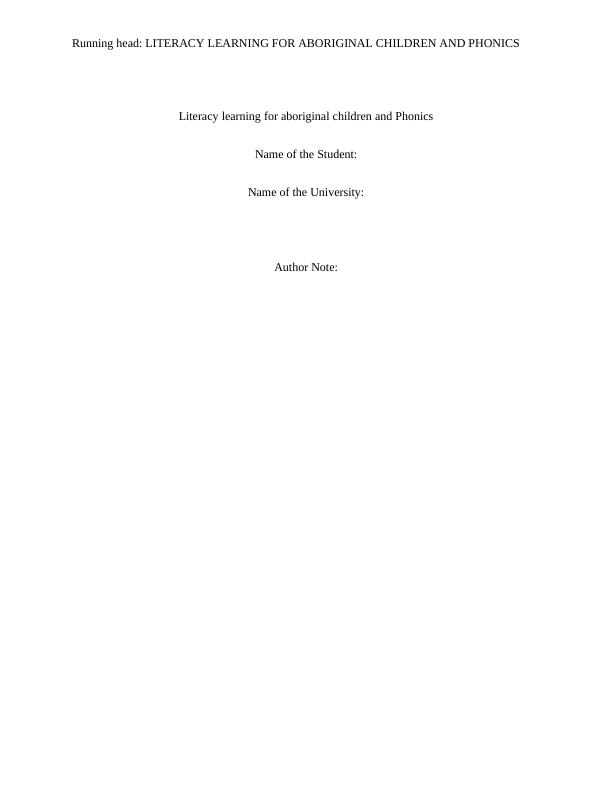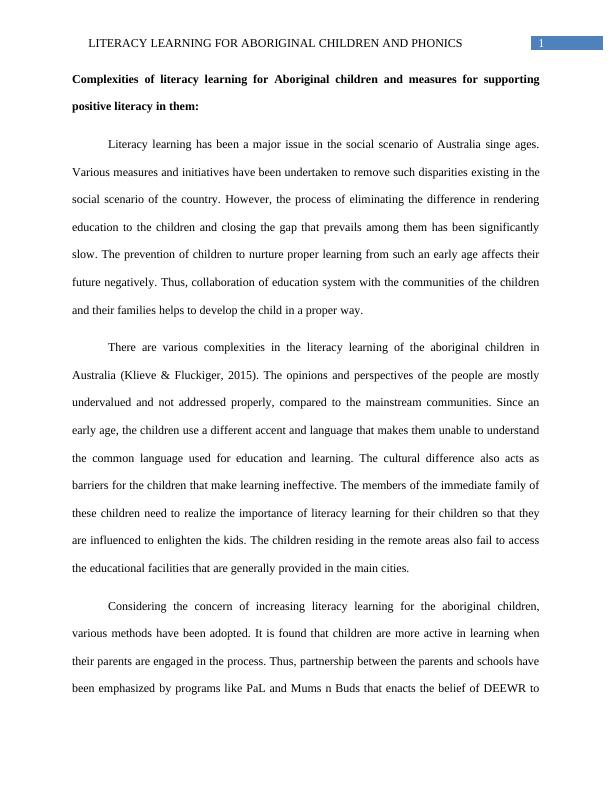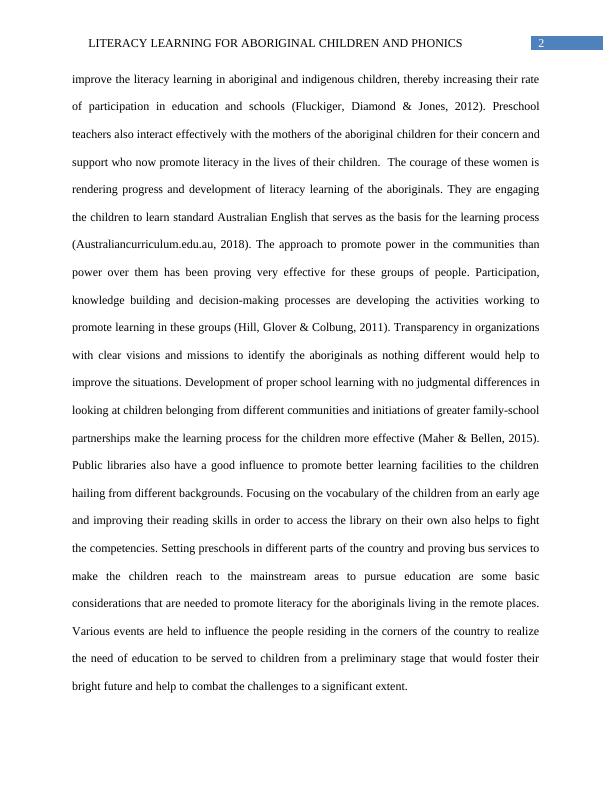Literacy learning for Aboriginal Children and Phonics Assignment
Added on 2021-04-21
7 Pages1766 Words33 Views
Running head: LITERACY LEARNING FOR ABORIGINAL CHILDREN AND PHONICSLiteracy learning for aboriginal children and PhonicsName of the Student:Name of the University:Author Note:

1LITERACY LEARNING FOR ABORIGINAL CHILDREN AND PHONICSComplexities of literacy learning for Aboriginal children and measures for supportingpositive literacy in them:Literacy learning has been a major issue in the social scenario of Australia singe ages.Various measures and initiatives have been undertaken to remove such disparities existing in thesocial scenario of the country. However, the process of eliminating the difference in renderingeducation to the children and closing the gap that prevails among them has been significantlyslow. The prevention of children to nurture proper learning from such an early age affects theirfuture negatively. Thus, collaboration of education system with the communities of the childrenand their families helps to develop the child in a proper way.There are various complexities in the literacy learning of the aboriginal children inAustralia (Klieve & Fluckiger, 2015). The opinions and perspectives of the people are mostlyundervalued and not addressed properly, compared to the mainstream communities. Since anearly age, the children use a different accent and language that makes them unable to understandthe common language used for education and learning. The cultural difference also acts asbarriers for the children that make learning ineffective. The members of the immediate family ofthese children need to realize the importance of literacy learning for their children so that theyare influenced to enlighten the kids. The children residing in the remote areas also fail to accessthe educational facilities that are generally provided in the main cities. Considering the concern of increasing literacy learning for the aboriginal children,various methods have been adopted. It is found that children are more active in learning whentheir parents are engaged in the process. Thus, partnership between the parents and schools havebeen emphasized by programs like PaL and Mums n Buds that enacts the belief of DEEWR to

2LITERACY LEARNING FOR ABORIGINAL CHILDREN AND PHONICSimprove the literacy learning in aboriginal and indigenous children, thereby increasing their rateof participation in education and schools (Fluckiger, Diamond & Jones, 2012). Preschoolteachers also interact effectively with the mothers of the aboriginal children for their concern andsupport who now promote literacy in the lives of their children. The courage of these women isrendering progress and development of literacy learning of the aboriginals. They are engagingthe children to learn standard Australian English that serves as the basis for the learning process(Australiancurriculum.edu.au, 2018). The approach to promote power in the communities thanpower over them has been proving very effective for these groups of people. Participation,knowledge building and decision-making processes are developing the activities working topromote learning in these groups (Hill, Glover & Colbung, 2011). Transparency in organizationswith clear visions and missions to identify the aboriginals as nothing different would help toimprove the situations. Development of proper school learning with no judgmental differences inlooking at children belonging from different communities and initiations of greater family-schoolpartnerships make the learning process for the children more effective (Maher & Bellen, 2015).Public libraries also have a good influence to promote better learning facilities to the childrenhailing from different backgrounds. Focusing on the vocabulary of the children from an early ageand improving their reading skills in order to access the library on their own also helps to fightthe competencies. Setting preschools in different parts of the country and proving bus services tomake the children reach to the mainstream areas to pursue education are some basicconsiderations that are needed to promote literacy for the aboriginals living in the remote places.Various events are held to influence the people residing in the corners of the country to realizethe need of education to be served to children from a preliminary stage that would foster theirbright future and help to combat the challenges to a significant extent.

End of preview
Want to access all the pages? Upload your documents or become a member.
Related Documents
Communication, language and literacylg...
|11
|2347
|126
Complexities of Literacy Learning for Aboriginal Children and Evaluation of Phonics and Whole Language Approaches to Teachinglg...
|9
|1614
|272
Advantages and Disadvantages of Phonics and Whole Language Approacheslg...
|9
|1527
|344
Challenges and Strategies for Literacy Learning in Aboriginal Childrenlg...
|10
|2164
|373
Evidence of Learning Using action Learning Principleslg...
|12
|2842
|65
Supporting Phonics and Early Mathematicslg...
|7
|908
|427
